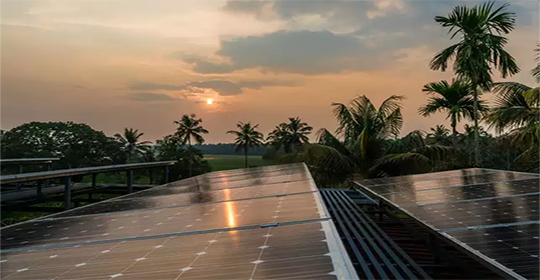Solar revolution? Far from it, says industry
Solar revolution? Far from it, says industry

Despite India's ambitious plans for the solar sector, incoherent policies, retrospective changes in law and a convoluted taxation system has spelt a death knell for the nascent industry.
India has ambitious plans of generating 100 GW of solar power by 2022. This is out of the total 175 GW the country plans to produce from renewable sources. Prime Minister Narendra Modi has also asserted in the past on how he wants the country to become a hub for the manufacture of solar power batteries. A report by KPMG revealed that solar power is a strategic need for the country as it can save $20 billion in fossil fuel imports annually by 2030 and domestic manufacturing can save $42 billion in equipment imports by 2030. Solar manufacturing, it said, can also lead to the creation of employment for more than 50,000 in the next 5 years.
However, there is a huge gap between intent and action. At a recently organized round table by ETRise with players from the solar sector, participants said at the heart of issues is the continued reliance on China to meet our solar hardware requirements. India, currently, does not manufacture solar panels and depends on Chinese imports to meet demand. India sought to reverse this trend by inviting bids to set up manufacturing solar equipments in May 2018.
However, no bids were received and the industry points to a clause which states the manufacturer is also required to build a solar park that generates 1.5 gigawatts of power. Since May last year the deadline to submit bids has been extended several times and it now stands at October 31, 2019. The tender in its current form wants developers to set up four projects for the module, cell, ingot and wafer manufacturing with an annual capacity of 500 megawatts each. "A manufacturer does not want to generate power. If manufacturing is the core competency of the bidder, the additional requirement of building a solar park is a problem. Also, if you look at our current demand and projections for the future, manufacturing aimed at 500 megawatt annual capacity is not enough," says Ankur Pathak , Head - Regulatory and Corporate Relations, Mahindra Susten.
Industry experts from the solar industry were unanimous in their view that the solar power industry needs an overhaul in mindset and regulatory policies to bring about a change in the sector.
The panelists suggested that setting up the manufacturing sector, even if expensive, remains imperative if the country's solar targets are to be achieved. "It needs to be treated as a strategic investment. Pay the capital cost from the government to entities like BHEL or invite interest from the private sector with suitable incentives. If the capital cost is paid, only the operational cost will be left to meet and then the cost of wafer may be kept low. The cost of the wafer is a substantial part of the cost of the cell and the module," added Deepak Gupta, Director-General, National Solar Energy Federation of India (NSEFI).




